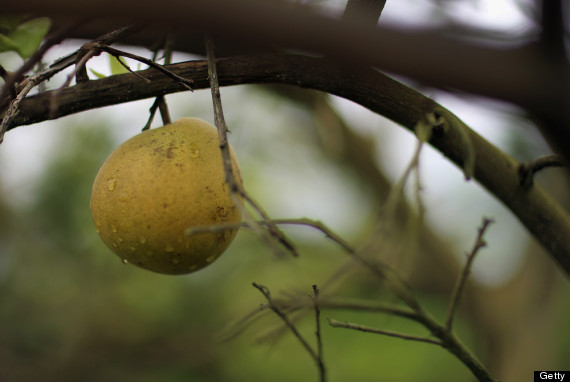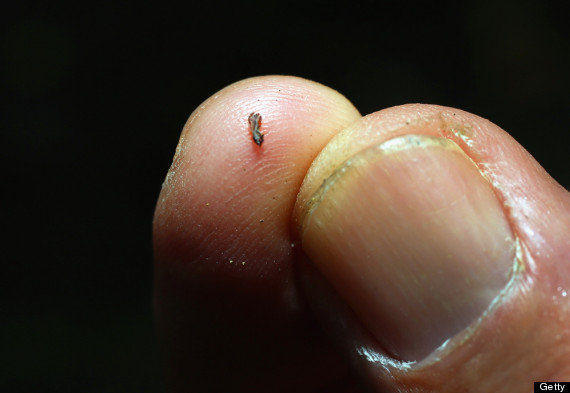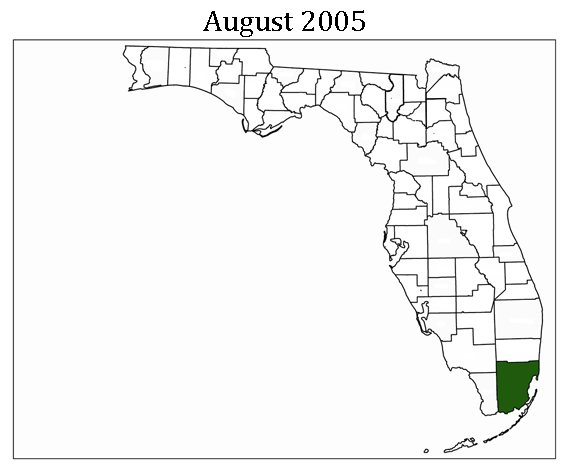By the spring of 2006, Maury Boyd had grown used to dealing with catastrophe. At 13, he had started working for McKinnon Corporation, his stepfather's family's citrus company comprised of thousands of acres of orange groves in Florida. In the 50 years since then, he'd helped the groves recover from freezes, hurricanes and a disease known as citrus canker -- all of which could easily have destroyed the business.
Yet even Boyd, now the president of the company, got scared when scientists from the Florida Department of Agriculture told him that his trees were infected with huanglongbing -- more commonly known as HLB or "citrus greening."
HLB is the most serious disease a citrus tree can contract. Within 18 months of infection, a tree's leaves develop telltale yellow splotches. Its fruit starts to turn green at the wrong end and taste so bitter that it's almost inedible. Limbs fall off. Roots decay. As little as four or five years later, the tree withers into a brown skeleton and dies. There is no cure.
Greening spreads rapidly through and between groves of any citrus fruit -- limes, grapefruit and, most notably for Florida, oranges. By the time it reached Boyd, just six months after it was first discovered in Florida on a pomelo tree on a farm outside Miami, it had already devastated the commercial citrus industries in Thailand, Vietnam, Saudi Arabia, the Philippines, Reunion Island, Indonesia and southern China. The only widely accepted solution was to remove infected trees and quarantine infected areas.
 |
| A grapefruit on a tree in Fort Pierce, Florida shows the signs of HLB. (Photo by Joe Raedle/Getty Images) |
Forty percent of the trees in some of Boyd's groves were already symptomatic, and Boyd knew that many more could be silent carriers of the disease. He did the math and realized that removing every infected tree would drive the McKinnon Corporation out of the citrus industry after a century growing oranges.
"The tipping point had arrived before we were even diagnosed," Boyd said, in the gravelly drawl he picked up at military school in Virginia.
Thousands of farmers across Florida were facing the same dilemma. Some decided to sell their groves to real estate developers. Others who tried to hang on watched helplessly as their trees stopped producing fruit and died. Many in the industry feared that the disease would soon accomplish what cold snaps, tropical storms and other diseases could not: destroy the Florida citrus industry -- taking orange juice, that rite of the American morning, along with it.
"There aren’t any citrus industries in the world that have encountered this disease and come up with a management system that allows them to continue to produce citrus in the presence of the disease long-term," said Harold Browning, one of the leading experts on HLB and the COO of the Citrus Research and Development Foundation in Lake Alfred, Fla.
"If you’re a pessimist," he continued, "You’ll say no one else has done it, so there’s a likelihood that HLB will take out the industry."
THE BIRTH OF AN EPIDEMIC
Like the black plague, huanglongbing came to the West from Asia.
There are actually two different types of the disease -- an African strain and an Asian one, each of which is caused by a different type of bacteria in the genus Candidatus liberibacter. American citrus trees have caught the Asian kind, which is spread from tree to tree in the saliva of aphid-sized insects called Asian citrus psyllids.
 |
| The tiny Asian citrus psyllid spreads HLB from tree to tree. (Photo by Joe Raedle/Getty Images) |
Once the bacteria enter the tree, they attack the innermost layer of its bark, known as the "phloem," which is to trees what blood vessels are to humans. This attack prevents the tree from effectively transporting water, nutrients and minerals between the roots in the ground and the leaves and fruit at the top, driving the tree into decline.
HLB was first clearly identified as an infectious disease, rather than a symptom of nutrient deficiencies, by a Chinese scientist named Lin Kung Hsiang. After earning a Ph.D. in agricultural sciences at Cornell in February 1941, he returned to his home country to conduct a study of citrus trees. He discovered that the groves in southeast China had been ravaged by a mysterious syndrome that local farmers called "huanglongbing," or "yellow dragon disease," after the yellowed tree shoots that are a characteristic sign of the disease. The farmers told Lin that they had known about the disease since the 1870s, but that it had only become a serious problem around 1936.
In 1956, Lin wrote a landmark treatise on HLB. But because he published it in communist China, his efforts went largely unnoticed by scientists in Europe and the Americas.
The disease continued to spread, becoming endemic in China, southeast Asia, the Indian subcontinent and southern Africa in the decades following the publication of Lin’s paper. By the end of the 20th century, it had killed over 100 million citrus trees across the globe.
But it still hadn't hit Florida, or Brazil's São Paulo State, which together produce more than 80 percent of the world's orange juice. When Asian citrus psyllids (or “jumping plant lice”) were first spotted in São Paulo State in the 1940s and in Florida in 1998, western scientists assured growers that none of the psyllids had tested positive for the HLB bacteria, so the risk of infection was slight.
Then citrus growers began to notice troubling symptoms. The glossy emeralds of their trees' leaves began to dull into mottled yellows. Some of their oranges and grapefruits started to turn green and bitter. In March 2004 and August 2005, scientists in São Paulo State and Florida, respectively, confirmed what some citrus growers already suspected: Greening had landed in the two biggest citrus-producing regions in the world.
Soon, HLB was epidemic in both regions. By February 2009, less than three years after the first positive HLB test on a citrus tree in Florida, the disease had spread to all 32 of Florida's citrus-producing counties.
 |
| An animated gif illustrating the spread of disease throughout Florida's citrus-growing region. (Joe Satran/The Huffington Post) |
The disease hit Florida at a particularly vulnerable time. The state's growers had been grappling with citrus canker for several years, compromising trees' immune systems and growers' ability to resist economic pressure. Hurricanes Charley and Ivan in 2004 and Wilma in 2005 destroyed farms throughout the state, just as real estate developers were scrounging for land. Adding HLB to the mix was like aiming a flamethrower at a pile of crumpled newspapers.
"It is perhaps the most devastating disease that the industry has faced," said Matthew Salois, the director of economic research at the Florida Department of Citrus.
These calamities pushed untold numbers of farmers out of the industry. Between 2004 and 2012, the amount of Florida land planted with citrus shrunk by nearly a third, a loss of area bigger than the city of Dallas. Citrus production dropped from 292 million boxes of fruit in 2004 to 171 million in 2012. Average orange yields have sunk from 428 boxes an acre in 2004 to 338 boxes an acre today, despite ever-denser plantings of orange trees. The wholesale price of Florida oranges, meanwhile, has almost tripled, from a low of $2.89 a box in 2004 to $7.96 a box in 2012.

0 Comments:
Post a Comment